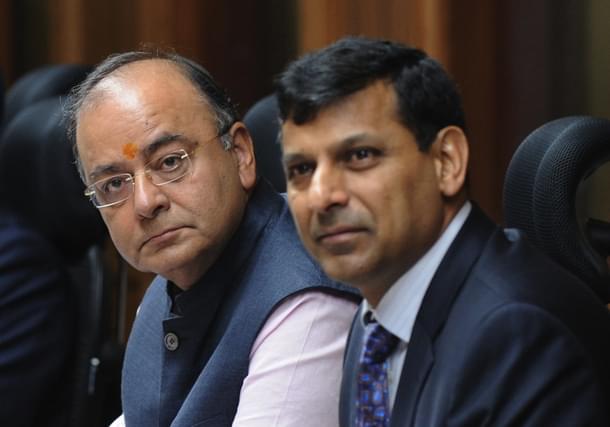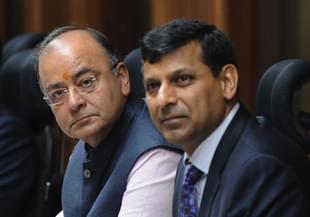Economy
Cleaning Of Banking Sector Is Better Than Tinkering With Interest Rates
Smiran Bhandari
May 30, 2016, 03:54 PM | Updated 03:54 PM IST
Save & read from anywhere!
Bookmark stories for easy access on any device or the Swarajya app.


With the RBI’s bi-monthly review meeting coming up in June, the debate on whether RBI should cut rates or not has heightened. Many experts opine that higher interest rates are leading to lower investments by private sector and hence the resultant debt overhang is leading to lower growth. Another reason that is provided to validate lower interest rates is the burgeoning stress and indebtedness in the financial system. With lower interest rates, companies will be in a better position to repay their debt which in turn will benefit the banks.
At face value, these arguments should be compelling enough for any central banker to cut rates at every opportunity. Yet, a deeper analysis would suggest that the answer to the interest rate question is not that simple. While there is no denying that lower interest rates do benefit corporates, the negative consequences of premature rate cuts should also be taken into account. There are many aspects that a central banker has to contend with before arriving at a decision.
Firstly, lower interest rates erode the purchasing power of households as they earn less income from their fixed deposits and other investments linked to interest rates. Senior citizens and retirees are affected as they are heavily dependent on interest income. Secondly, easy money has a propensity to create higher inflation especially in developing nations like India.
Inflation is a bane which significantly affects the lower income classes as higher prices typically lead to lower consumption. Thirdly, companies tend to over-borrow at the prospects of cheap money. This leads to a difficult situation for many companies if things don’t go according to plan or when interest rates increase. Fourthly, as has been noticed in the past across the globe, loose monetary policy lead to asset bubbles which eventually leads to a financial crisis once the day of reckoning arrives and the bubble bursts. Finally, in the Indian context, banks are unable to fully transmit the benefit of reduced interest rates, thereby diluting the objective of cutting rates.
Essentially, the debate between the interest rate hawks and the doves boils down to taking sides. Rate cut advocates sympathise with the business community as they see many of them struggling to repay their debt. On the other hand, interest rate hawks take the side of households by cautioning about the ill-effects of demand side inflation and lower fixed income. In such a case, it is critical to maintain a balance between the concern of corporates and the requirements of households. If interest rates are kept too low for too long, households suffer due to reduction in purchasing power. On the other hand, in the high interest rates regime the economic activity is low as corporates suffer from debt overhang and unable to repay debt.
Central Bankers grapple with this question on a regular basis and usually have to face questions regarding a perceived bias towards either corporates or households. To mitigate this bias, many economic policy thinkers suggest a more rule based monetary policy rather than a policy based on the discretion and judgement of the authorities. While the scope for some discretion is undeniable, rules based policy-making enable policymakers to bring in more certitude and stability in their framework. In India, RBI Governor Raghuram Rajan has linked interest rates with Consumer Price Inflation (CPI) while stating that real interest rates would be 1.5-2 percent higher than CPI. With CPI having steadied at around 5%, the interest rates should ideally be in the 6.5-7 percent range to reside in the comfort zone set by the Governor. Hence, with the rule based monetary policy there is little scope for Rajan to cut rates from here.
At this juncture, many growth advocates are proposing to apply discretion and substantially reduce the interest rates so as to kickstart the economy. While there is some merit in this argument, it may not turn out to be as fruitful in an uncertain global economy where growth is hard to come by. In the current scenario, most long-term investors across the globe are sitting on their cash reserves and preferring to wait. As can be seen in developed nations, an overly accommodating stance by central banks has not resulted in a widespread recovery yet. In India, a similar situation can arise where lowering of interest rates may not lead to a proportionate increase in economic activity as measured by GDP.
Rather than abandoning its rules based approach to monetary policy, RBI should continue with its inflation targeting approach while focussing on the NPA problem which is curtailing lending capacity for banks. In fact, RBI should work more closely with banks to ensure that bad loans are being recognised and being provisioned for. Once there is a systematic cleanup of the banking system, financial institutions will be able to start with a clean slate and revive the much needed lending activity for corporates.
A slowdown in corporate lending is linked more to the declining global growth rather than high interest rates. Also, crony capitalism and fraudulent behaviour by bankers in credit decisions have not helped matters at all. Hence, a proper clean-up of the banking system may do a much better job of revving up the financial system rather than willy-nilly reducing the interest rates.
Smiran is an MBA graduate with years of experience in the business and entrepreneurship space. He tweets at @Smiranb and can be reached on email at smiranb@gmail.com.





